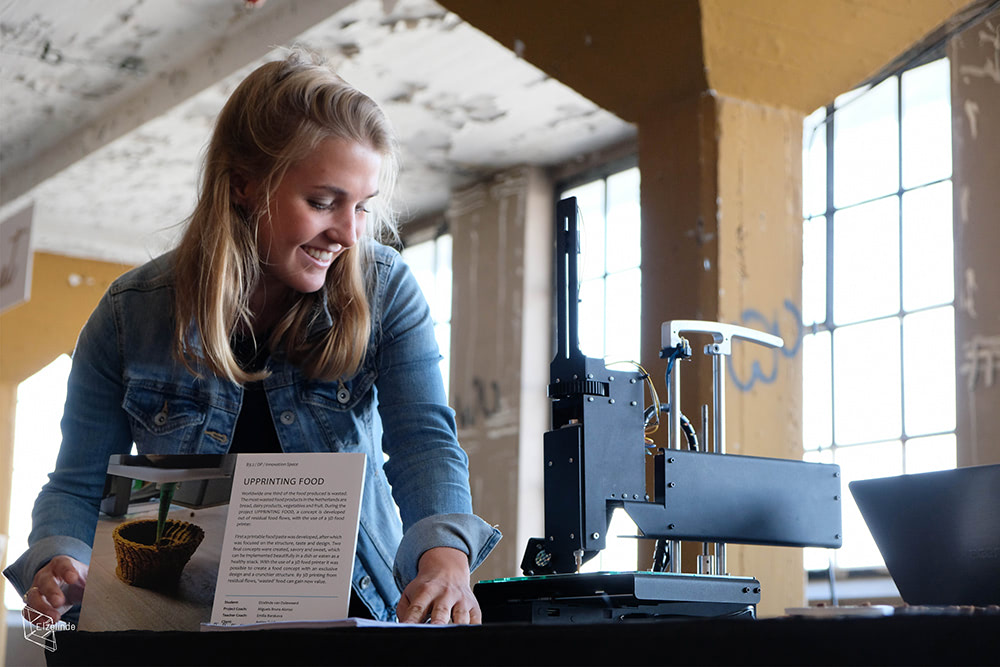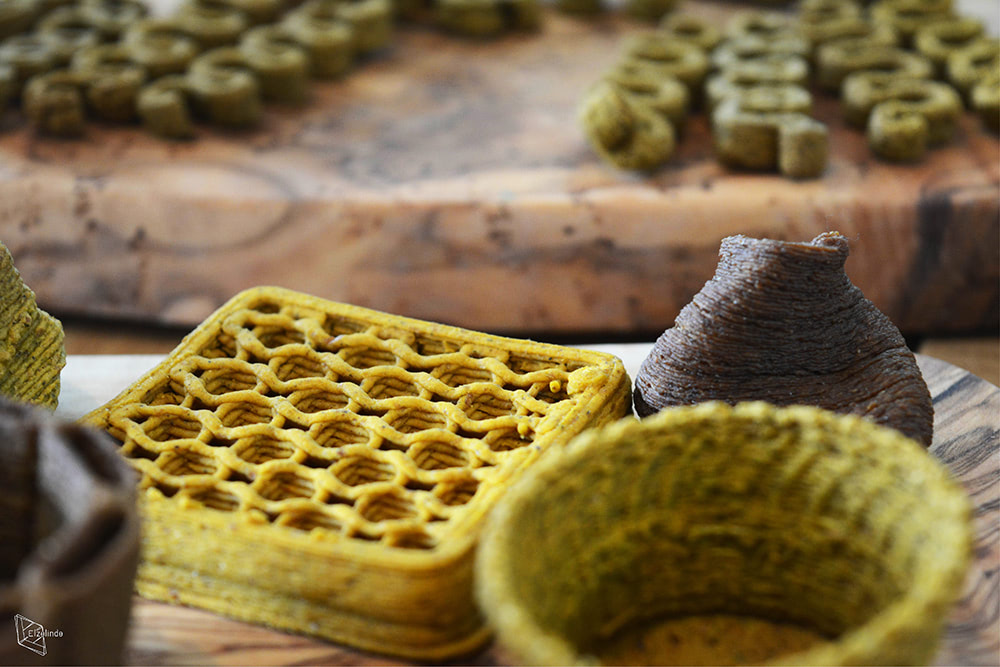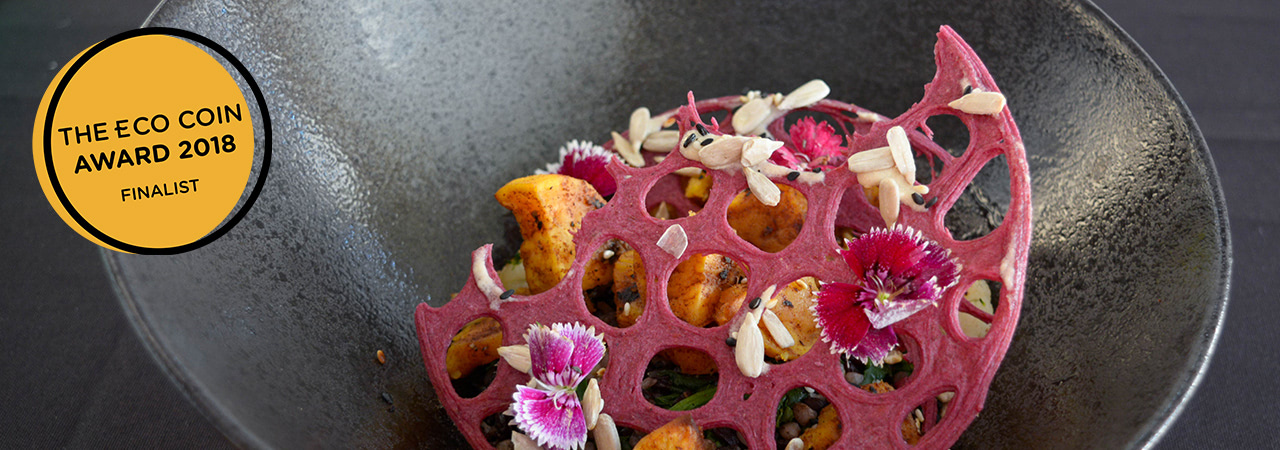Globally, humans produce enough food to feed 10 billion people (we are only 7 billion now) yet somehow we waste a third of this. Food waste is one of the biggest climate challenges of our time. Luckily there are some brilliant ideas out there aiming to tackle this global problem. The ECO coin Award 2018 looks to recognise these innovators and has nominated 3 international projects. These nominees caught our attention with their out-of-the-box concepts, international communities and strong visions on the future of food.
As part of our quest to this year’s winner, we’re interviewing each of the three finalists to learn about their values, insights and future visions. The third and final nominee is Upprinting Food, a young company utilizing the technology of 3D printing to upcycle food waste into edible products. The project is developed by Elzelinde van Doleweerd, Industrial Design student at Eindhoven University of Technology. In this Q&A, we talk to her about her inspiration, work process and future goals.
How and when did you get into the topic of food design?
I love to cook and I enjoy to express my creativity in the kitchen when experimenting with ingredients. Next to that, I followed a bachelor in Industrial Design at the Eindhoven University of Technology and simultaneously worked in a kitchen.
Because of my interests in both food and design, I preferred to really focus my vision on food design. To gain more knowledge in this topic, I did a minor in Food Technology in Wageningen. Afterwards, I finished my bachelor in Eindhoven with the food design project Upprinting Food. Because the project was well received, I recently started a company together with Vita Broeken to develop Upprinting Food further and bring it to the market.

How do you go from food waste to 3D printed products?
The 3D printed food is made from residual food flows of several ingredients. I started using bread, because bread is the number one wasted food product in the Netherlands. Next to that, we use fruits and vegetables which are often thrown away, because they are too ripe or not beautiful enough to be sold. And when we went to Beijing with this project, we used cooked rice instead of bread.
To create a printable food paste, we came up with several recipes in which we combine different food products. We mash and sieve the pastes and create more interesting flavours by adding herbs and spices. The printable food pastes consist for more than 75% out of residual food flows.
The printable food pastes consist for more than 75% out of residual food flows.
We fill a syringe with this paste and we insert this in the printer. We create 2D and 3D designs on the computer, which can be send to the printer. When the food is printed, we bake and dehydrate to food, to create a crunchy structure and to be able to save the food for a very long period.
What challenges did you encounter in the development of the project?
The biggest challenge was to create a printable food paste from bread, fruit and vegetables. When I first succeeded in doing this, the structure was very tough and not very nice to eat. After more than 80 experiments, I finally created the first two printable recipes from residual food flows with a nice taste and crunchy structure.
You recently exhibited the project at the Dutch Design Week 2018. What kind of reactions did you get?
People thought it was beautiful! They were very enthusiastic about the food structures, the dishes we prepared with the samples and the food they could try. People were curious about the contents of the different samples and they gave several suggestions on what to do with it. Some people actually did not believe that is was edible at all! Also, we received interests from restaurants and several interesting potential partners.

The project is still quite small-scale. What are the possibilities of upscaling and industrializing it?
We are going to follow a traject to really upscale the process and to bring it to the market. In order to make the process faster, we need to upscale the printer to include multiple nozzles and a larger paste "tank". We are currently working with a developer to create a new printer for us.
Furthermore, we are planning to do some market analysis, talking to cooks, farmers, restaurant owners, consumers, etc. to figure out what their needs and wishes are.
What will be the next step in the Upprinting Food project?
The next step for us now is to work with restaurants. We want to analyze their residual food flows, to create new recipes for printable food pastes out of those ingredients and to print it in beautiful shapes which can be implemented again beautifully in the food they serve.
Future steps of the technology might include creating food from residuals from supermarkets and bringing that back into the supermarket to be able to sell it on a large scale. We could also look into how we could use the printer to create foods, which can be shipped internationally to prevent hunger in other countries.
In the meantime we are working on new recipes and designs, with different food ingredients. Residual food flows change with the seasons and therefore our recipes should change and grow according to these residues.
Lastly, we have several (international) exhibitions planned in our agenda, showing people how beautiful 'food waste' can be and getting in contact with more restaurants.
Showing people how beautiful 'food waste' can be
You're nominated for the ECO Coin award, which celebrates innovations in sustainability. How do you feel your work fits in with broader sustainability efforts?
Next to processing Upprinting Food with residual food flows in the restaurant sector, we want to show consumers how much food, which they normally throw away, is actually still edible. Most people enjoy the printed foods if they see the beautiful structures, but when we tell them that it is actually made from residual food flows, they are quite surprised of what kind of beautiful, tasty food you can still create out of those food flows.
In doing so we hope they will be more conscious about the food they throw away. But also that they start asking questions about other forms of food waste, for example the "ugly" produce that is not sold. Hoping that eventually people will give value to these products and become more creative with their residual food.
Do you think that Upprinting Food should win the ECO Coin Award 2018? Cast your vote by tapping the heart below!

Share your thoughts and join the technology debate!
Be the first to comment